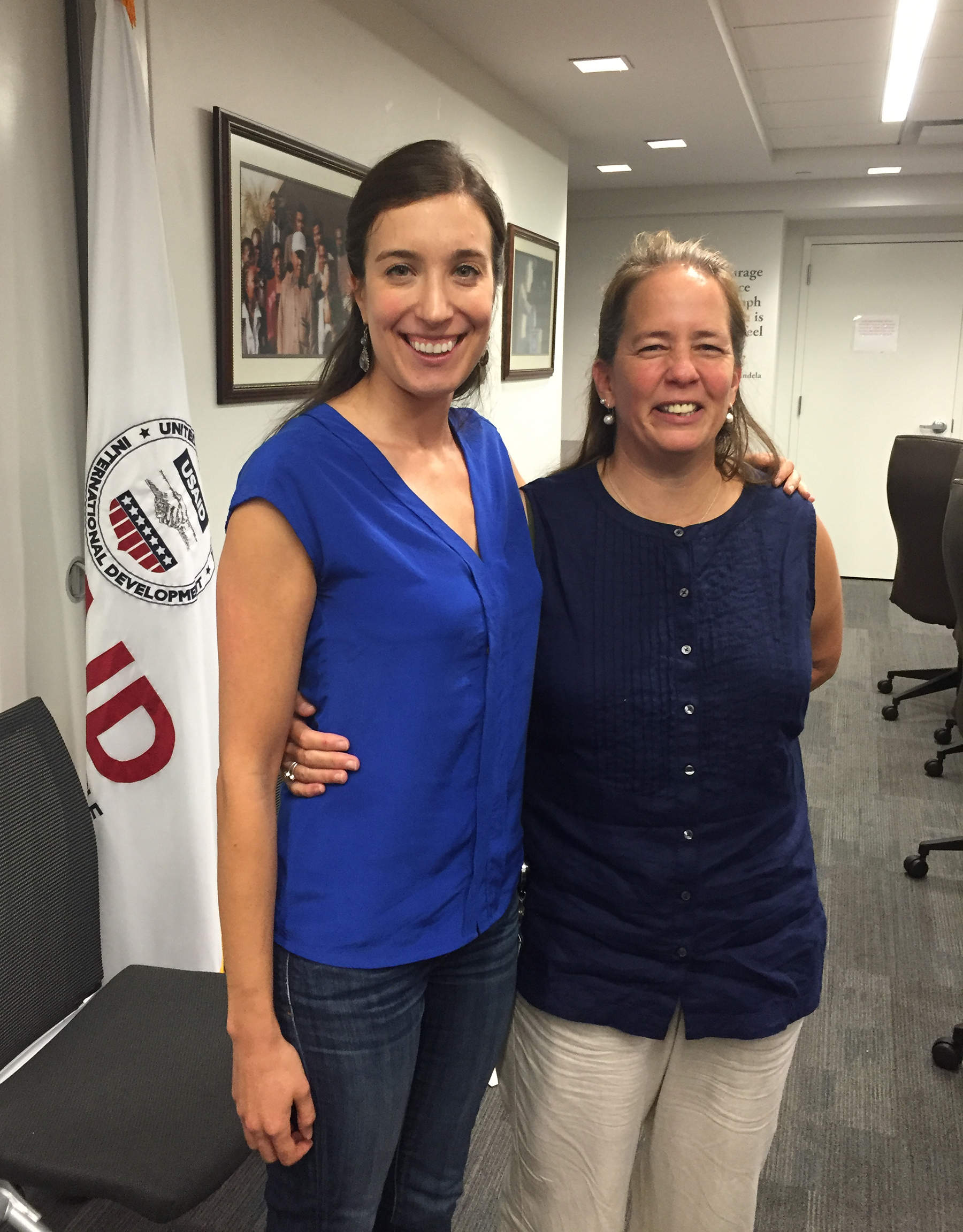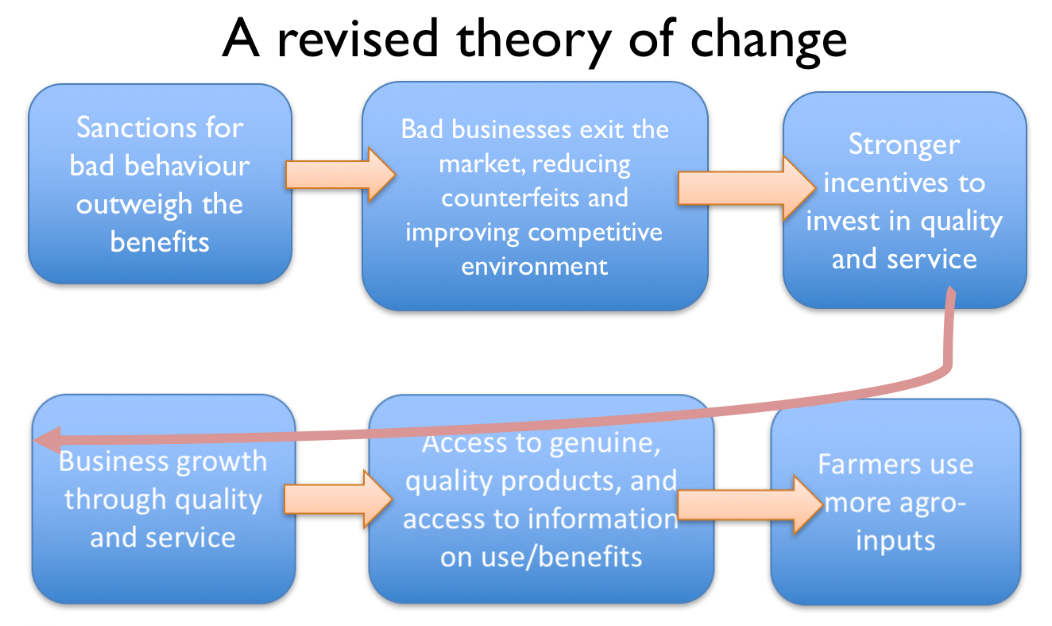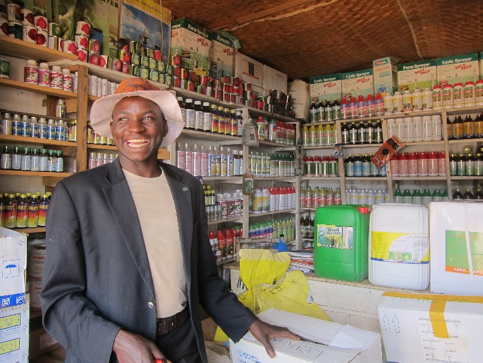CLA in Action: A Revised Theory of Change for Uganda’s Agricultural Inputs Activity

This CLA in Action case study was a finalist in the 2015 CLA Case Competition. The visual notes above are from Jennifer Peterson and Dr. Rita Laker-Ojok’s recent presentation in USAID’s CLA in Action Brown Bag series. Pictured: (left) Reena Nadler, Knowledge Management & Organizational Learning Specialist, USAID/PPL, and (right) Jen Peterson, Associate/Agriculture and Economic Growth, Tetra Tech. (Amy Leo).
Low-Quality Agricultural Inputs Present a Development Challenge
Counterfeit fertilizer is a big problem in Uganda. Fake Roundup is nearly indistinguishable from the real thing (see image below) and fields unknowingly sprinkled with filler substances like sand and gravel languish undernourished. This case study from the 2015 CLA Case Competition outlines how USAID implementing partner Tetra Tech is collaborating, learning, and adapting (CLA) to address this development challenge.

The USAID/Uganda Mission’s support for using CLA approach prompted Tetra Tech to integrate it throughout the design of the Agricultural Inputs Activity, but the need to measure and track systemic change, and the goal of achieving long-term sustainability, were other factors in this decision.
Taking the entire local economy and all stakeholders into consideration, Tetra Tech’s theory of change for this activity predicted that the market would reward quality players in the agricultural inputs retail space and sufficiently sanction counterfeiters, putting them out of business. The expected result was that farmers would have access to and use more quality agricultural inputs. Guided by this theory of change, Tetra Tech identified key leverage points and established strategic relationships with businesses to encourage a new norm of quality, customer service, and investment with the goal of long-term business growth.

Throughout the activity, CLA took the form of formal and informal, regular and opportunistic collaboration with multiple stakeholders at multiple levels, after action reviews, quarterly reviews, stakeholder surveys, strategic assessments and special studies.
A Theory of Change in Need of Change
The results of a mid-activity strategic assessment in June 2015 became a test of the activity’s level of CLA integration. The assessment determined that the underlying assumptions underlying the initial theory of change did not hold. The incentive to behave well and invest in quality and service was not strong enough given the market conditions and the types of behavior that the market was rewarding. Given that fact, Tetra Tech needed to find a way to change those sanctions and incentives to make investment in quality inputs both feasible and profitable for businesses.

Tetra Tech developed a revised theory of change which used system pressure to create changes in practices rather than pressuring businesses directly (see graphic above). This required significant changes in the activity's day-to-day operation with accompanying changes in strategy, tactics, and organization to achieve the desired outcomes.
What difference did CLA make to project outcomes?
Tetra Tech reports that CLA:
- Enabled staff to focus on outcomes versus outputs
- Increased opportunities for local level adaptation
- Built partnerships that increased effectiveness and efficiency
- Led to information-based decision making
- Created the conditions for a revised theory of change
Adopting a new theory of change was possible through the adaptable mechanism of Tetra Tech’s contract, which was based on outcomes versus outputs and included flexibility for local-level adaptation of their proposed interventions. Although this type of mechanism can be more time-consuming than direct implementation because it involves more real-time decision making, it allowed Tetra Tech to translate the learning that came from their strategic assessment process to action. Tetra Tech was able to realign their priorities in the face of a changing local landscape and recalibrate the activity for success in the second half of contract implementation.

The USAID/Uganda Mission’s CLA-friendly culture was crucial. For example, the mission’s culture of openness created the conditions for all stakeholders to be open to honest feedback from the strategic assessment. This allowed the mission to test and experiment with various strategies and, ultimately, made space for developing a new theory of change. In addition, the Contracting Officer Representative for this activity and the Mission in general offered their support and flexibility in the face of change.
While the Agricultural Inputs Activity is not yet complete, Tetra Tech reports that:
- Of 1023 agro-dealers trained last year, 91% are making business changes
- More than half of all agro-dealers save time and money by having suppliers deliver inputs directly to their shops
- 40% of agro-dealers are satisfied with District Local Government efforts to combat counterfeits
- The Activity is reaching 9000 women and youth
Click here to learn more about the Feed the Future Agricultural Inputs Activity.
Pictured above left: Counterfeit fertilizers in Uganda are nearly indistinguishable from authentic ones. (Tetra Tech). Pictured above right: Tetra Tech developed strategic partnerships with agro-business owners. (Tetra Tech).



